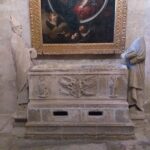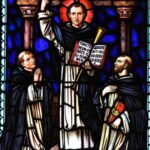St. James Intercisus
Saint James Intercisus
Unyielding Faith: The Legend of St. James Intercisus
When they lived:
St. James Intercisus, known for his unwavering devotion to his faith, lived during the early 5th century.
Where they lived:
He resided in the ancient city of Nisibis, a significant cultural and religious center in Mesopotamia, located in present-day Turkey.
Notable world events during the time of their life:
- Fall of the Western Roman Empire (476 CE): As the Roman Empire faced its decline and eventual fall, the world witnessed the end of an era. Amidst this tumultuous period, St. James Intercisus remained steadfast in his convictions, providing hope and inspiration to those around him.
- Council of Ephesus (431 CE): In 431 CE, the Council of Ephesus, a landmark ecumenical council of the Christian Church, took place. During this time, the Church was grappling with theological disputes, but St. James Intercisus’ unshakable faith served as a beacon of unity and devotion in the face of uncertainty.
- The Huns’ Invasions (late 4th-early 5th century): The Huns, led by their fierce leader Attila, launched several invasions, spreading fear and chaos across Europe and Asia. Amidst the chaos, St. James Intercisus’ courage and resilience stood out, becoming a symbol of hope for those facing adversity.
- The Fall of Nisibis (363 CE): Nisibis was conquered by the Persian Empire in 363 CE, resulting in significant upheaval and displacement. It was during this challenging time that St. James Intercisus demonstrated his unyielding faith, even in the face of political and territorial changes.
Their patronage:
St. James Intercisus is revered as the patron saint of faith, courage, and religious tolerance. He is often invoked by individuals facing challenges to their beliefs or encountering difficulties in their spiritual journey. Moreover, he is considered a protector of communities enduring times of war and turmoil, as his life serves as a testament to the power of steadfast devotion in the most trying circumstances.
Legend has it that despite facing persecution and threats to renounce his Christian faith, St. James Intercisus bravely chose martyrdom. His defiance of oppression and his resolute refusal to compromise his beliefs earned him the title “Intercisus,” meaning “the cutter” or “the dismembered” in Latin, as he was brutally executed for his faith.
Life and devotion
Saint James Intercisus is also known as Saint James the Mutilated. He was a Christian martyr.
There is no detailed information about how the saint lived. It is known that he was born in Beth Huzaye, Persia.
His day of birth is unknown. There is no data that talks about who his parents were or if he had any siblings.
There is no record of where Saint James Intercisus received his education.
Saint James was a military officer and adviser to King Yazdegerd I. It was during this time that Christians were being persecuted by Yazdegerd.
Saint James was a devoted Christian. It must have been really difficult to practice your religion when you worked in such close proximity with a man who had sworn to eradicate Christians.
Afraid for his life, Saint James Intercisus had renounced his religion in order to escape the wrath of the new law.
This disappointed his family members, who refused to do the same. After King Yazdegerd I died, Saint James’ family reached out to him.
They reprimanded him for denouncing his faith. This saddened James, and he had a rethink.
He realized how far he had been from God. He realized that in his quest to stay alive and maintain his position in society, he might have fallen short of glory from heaven.
Wanting to make up for his betrayal of Christianity, he went into the presence of Yazdegerd’s successor, Bahra. V. There, in front of everyone, he confessed to being a Christian.
Enraged, King Bahra sentenced Saint James Intercisus to death.
Death and Canonization
Saint James Intercisus died in the year 421 A.D. in Beth Lapat, Persia.
Intercisus in his name literally means “cut to pieces”, detailing the manner of his slow and painful death.
History records that James Intercisus was hung from a piece of wood and then cut into small pieces. He survived each cut, starting with his fingers, until he was beheaded.
He had instructed his followers on how he wanted to be buried. To honor his decision, they asked for the pieces of his body. Their request was denied.
This led them to sneak into the grounds at night and steal the body parts. History documents that the body parts were transferred to the Cathedral of Braga in Portugal and kept in a sarcophagus.
There are several religious institutions that are dedicated to Saint James Intercisus.
A piece of Saint James’s bone is said to have been placed in a gold cask and kept in a kurishupally.
Saint James was canonized pre-congregation. He is celebrated in the Roman Catholic Church, the Syrian Orthodox Church, the Eastern Orthodox Church, and Oriental Orthodoxy.
He is celebrated on the 27th of November.
5 Interesting Facts About St. James Intercisus
- Did you know that Saint James Intercisus is the patron saint of
victims of torture? - Did you know that Saint James Intercisus was cut into 28 pieces?
- Did you know that even in death, while in pain, Saint James
Intercisus refused to renounce his faith for the second time? - Did you know that Saint James Intercisus shares a similar story with
James of Beit and James of Karka? - Did you know that the ruins of Beth Lapat, where Saint James
Intercisus was killed near Dezful, Iran.
Prayer to St. James Intercisus
O God, who was pleased to give light to your Church by adorning blessed James the Intercisus with the victory of martyrdom, graciously grant that, as he imitated the Lord’s Passion, so we may, by following in his footsteps, be worthy to attain eternal joys. Through our Lord Jesus Christ, your Son, who lives and reigns with you in the unity of the Holy Spirit, one God, for ever and ever Amen.
Source:[https://www.google.com/amp/s/vitaesanctorum.wordpress.com/2015/11/27/st-james-intercisus-martyr/amp/]{.ul}



